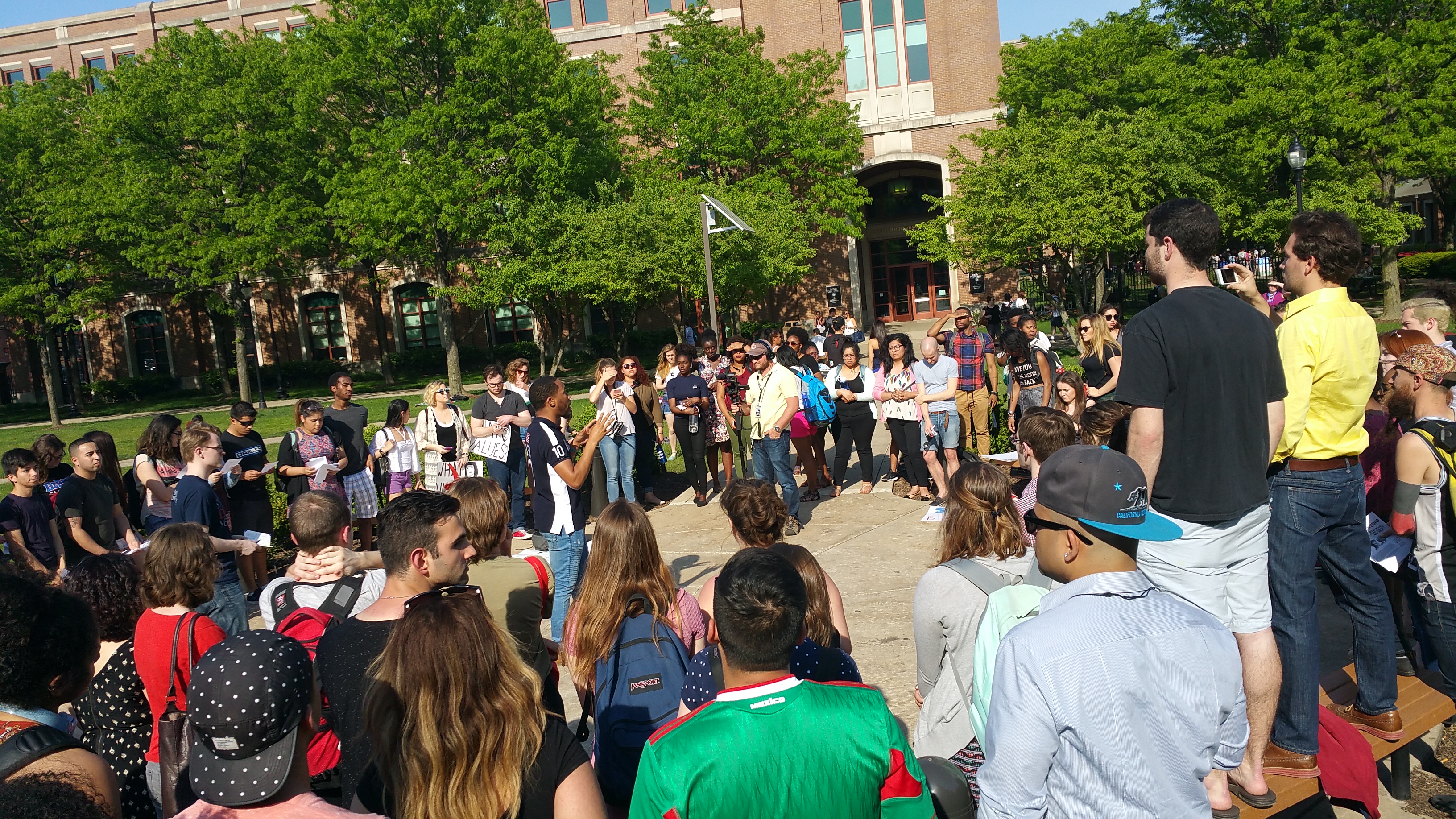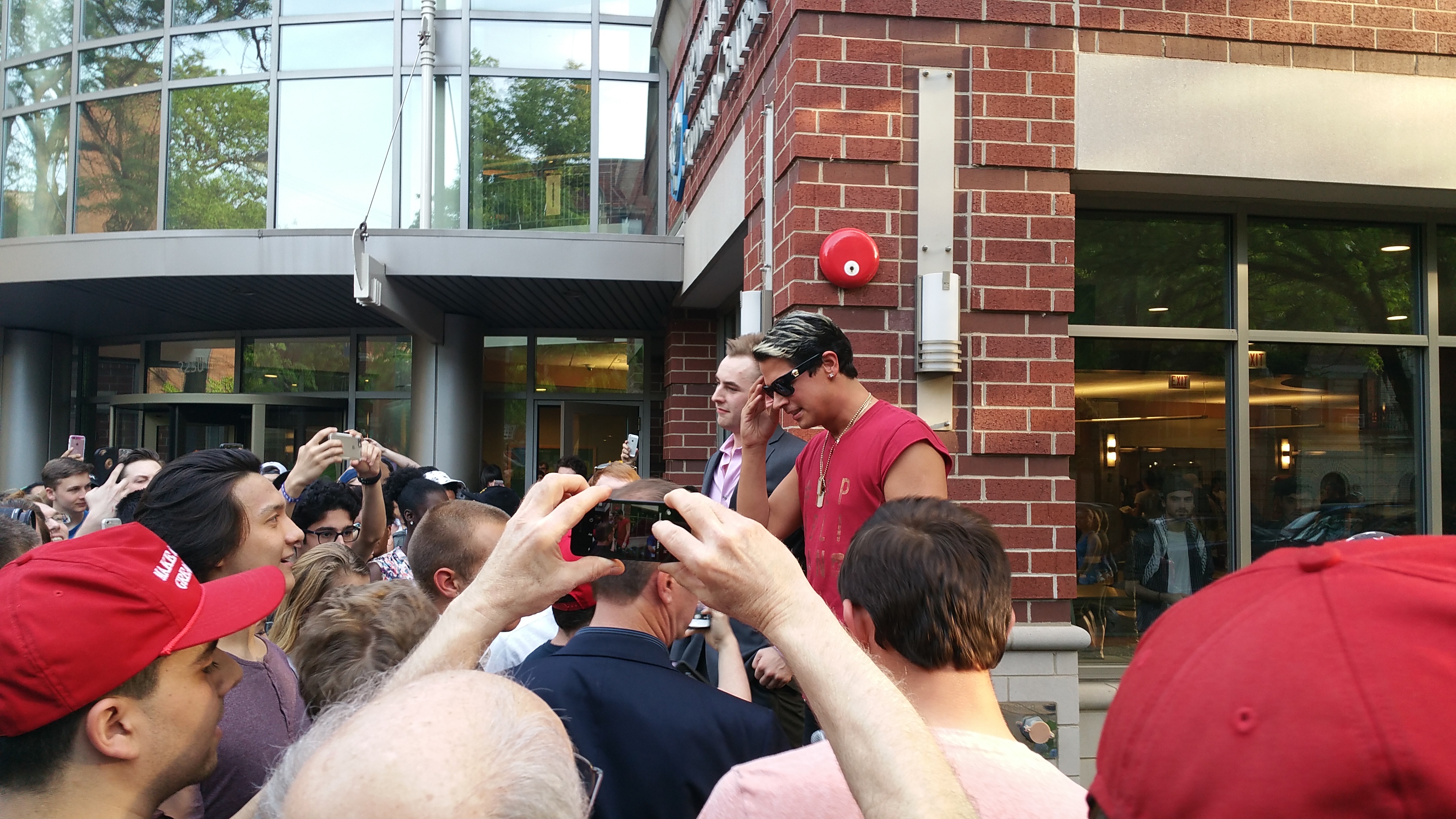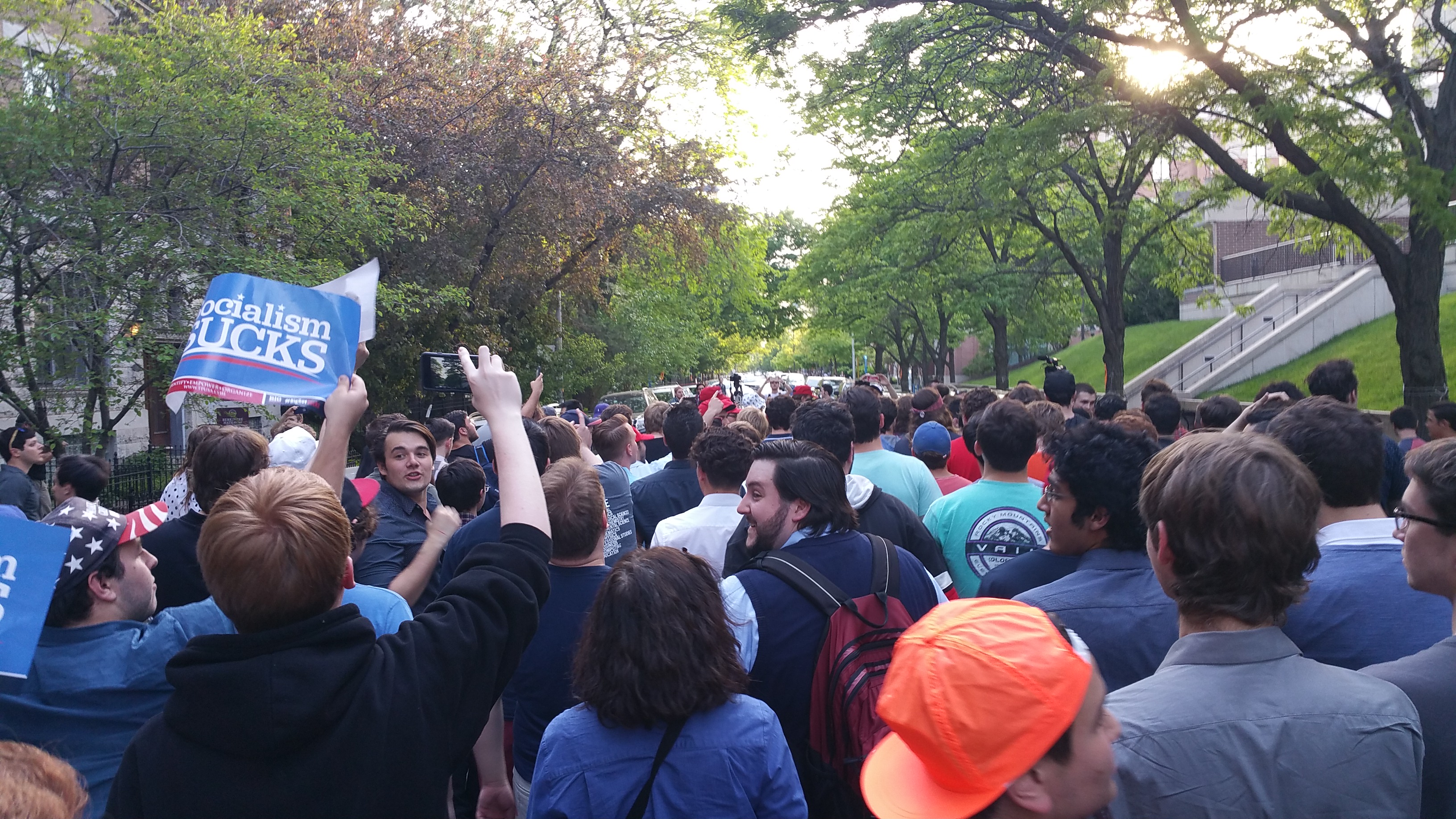A convergence of time, place and Milo Yiannopoulos
All things considered, the day started off pretty quiet.
May 24 was hot—hotter than it had been for months—and DePaul’s Quad was covered with bodies stretched across the grass, lounging in shade or open to the sky. The air felt thick and drowsy, saturated with a kind of exhaustion exclusive to Midwesterners after the bite of winter and slog of spring.
Tom Rietz (my roommate, for the record) and Kyle Morrell were sitting on a bench by the Schmitt Academic Center and looking for a spot of their own. It was early—they still had half an hour before the ball would start to roll—but they seemed prepared for whatever was about to happen.
Across the way, a lone Public Safety officer strolled down one of the stone paths from University Hall towards the Richardson Library. He occasionally stopped to sip a light blue can of Monster and look over his shoulder. At one point, he swung abruptly towards the sound of cheering and clapping from inside the library’s atrium. It was difficult to know what was going through his mind as he continued his round.
With 15 minutes to go, Rietz, Morrell, and an unaffiliated sunbather sat inside the ring of concrete at the center of the Quad, freshly scrubbed of graffiti to the tune of “F— Mexico” from the night before.
With five minutes to go, the crowd had roughly doubled.
And 10 minutes later, I looked up from an interview to see that a crowd—a real one—had lurched into being. Well over a hundred students were suddenly crammed between light fixtures and bushes and waiting to hear speeches given in support and solidarity, whatever that means.
Two weeks earlier, Rietz had created a Facebook event titled “Don’t Feed the Trolls—Students Against Hate Speech.” It was a reaction designed to “draw attention away” from another event that DePaul College Republicans had organized and paid for themselves: a visit from Milo Yiannopoulos as part of his Dangerous F— Tour. As the name might suggest, Yiannopoulos has made a brand for himself by trumpeting his freedom of speech and tearing into academia’s newfound love for “safe spaces.” His searing commentary against feminism and social justice has given him folk hero-status for young conservatives across the country, while his British accent handily lends an intellectual credence to everything he says.

Rietz and Morrell didn’t want to call it a protest. It was a rally. A “counter event” to the other event that was bad. Morrell had referred to it as a “protest of ideas” to distinguish it from protesting the actual speech. The reason they had moved the demonstration to the Quad from its original spot outside the Student Center (where Milo’s speech was taking place) was to ensure that it wouldn’t spill into a shutdown. The last thing anyone wanted was a display of censorship that Milo would have undoubtedly relished.
Speakers stepped into the ring one at a time. They were angry: angry at DePaul’s administration for trying to stay above the fray, at the people who roamed Lincoln Park with their “Make America Great Again” hats, at the people who belittled their lived experiences when they stood up to defend them, and at a speaker who claimed to be governed by logic and facts while asserting that birth control made women fat and crazy. A chorus of snaps rose and fell with every righteous line.
Neither Rietz or Morrell were really the “thought leaders” behind the event. They gave no speeches themselves, while Rietz moderated and kept track of the speaking order. They wanted to facilitate thoughtful and civil discussion, a platform for students who believed they’d been marginalized by hateful speech taking place a block or two away.
The original aim of Rietz’s protest was unambiguous. Towards the end of its mission statement on Facebook, he wrote, “DePaul students will not feed the troll by attempting to silence him, but will instead show solidarity with those he marginalizes at the DePaul.”
The protest was never his to control. Not really. Its eventual, actual destination was clear long before demonstrators began to march down Belden, despite promises made to keep activity outdoors. From 5 p.m. until 5:45 p.m., the plan was to listen. From 5:46 p.m. to 5:51 p.m., the plan was to march. After 6:10 p.m., their schedule would open up considerably. It would have taken something more powerful than faith to believe that every participant would pack up their things and head home after their 20 minutes of allotted demonstration time next to the Father Egan statue.
As the group prepared to move, I asked one observer I’d seen at other events over the course of the year what he thought of the demonstration. On the condition of work-related anonymity, he said it had done what it set out to do. He also supplied a caveat.
“Do I think it might be a little misguided?” he asked. “Sure. I don’t necessarily agree that everything Milo says is hate speech, but, at the same time—”
At that moment, the crowd cut him off with their first chant—“RACIST SEXIST ANTI-GAY, RIGHT-WING BIGOTS, GO AWAY!”—and embarked on their march. The observer bit his lip halfway between a grimace and a grin.
“The subject matter is very touchy,” he said after a moment. “I don’t think people understand that the right and left speak completely different languages, even if they’re both English.”
As we walked, I asked Morrell a question I’d heard a bystander mutter during one of the speeches: Isn’t it sort of counter-intuitive to host an event that draws attention away from another, when the popularity of a counter event would inherently contribute to the popularity of the actual event?
It was a Catch-22, he admitted. “If you do nothing, you’re complacent. If you do something, you’re implicit in creating attention.”
“But what’s important to everyone here is that we’d rather have this moment to say that this is not the kind of speech we want at this campus,” Morrell said.
At 6:02 p.m., the shouts began in earnest on the corner of Belden and Sheffield: “Black Lives Matter!” followed by, “No Justice—No Peace!” After an unsympathetic cameraman without a DePaul affiliation got into a spat with students, “Shame on you!” ripped through the crowd with an angry, rhythmic urgency.
At 6:13 p.m.—approximately two minutes and 33 seconds after the protest officially ended—some two hundred students found themselves inside, up against the locked doors of Room 120 A&B. The cameraman had been swept inside with the crowd (despite gentle urgings from Public Safety that he really ought to leave the private property of our private school) and was telling everyone within earshot that he was within his rights to film “in his safe space.” He had the comedic instinct of a limp sock.
At 6:15 p.m., the boys in blue from the Chicago Police Department arrived, presumably to take him away. As they navigated the mass of students, the crowd welcomed them with predictable hospitality: “HANDS up! Don’t shoot! HANDS up! Don’t shoot!” They were gone as quickly as they had come.
At 6:19 p.m., things escalated. As an audience member came out into the lobby to help with security, a hand shot out to catch the door, and a heap of bodies surged to fill the gap. Those towards the back immediately cried out: “NO!” “STOP!” “IT’S WHAT HE WANTS!” It was the moment they all seemed to have anticipated, although with a mix of dread and helplessness. Only a few managed to get inside, but—reportedly with the help of a persistent whistle—they did it. They shut him down.
Outside, the fever broke. The crowd began to settle. One protester hopped onto a table and informed the room that she didn’t “need you telling me to be peaceful” to muted snaps. Confirmation that Yiannopoulos had stopped talking moved slowly from one side of the room to the other, leaving a mix of celebration and consternation in its wake.
Then, the other shoe dropped.
The crowd’s objective shifted. Plans were made to cover every entrance of the building to make sure Yiannopoulos—and his supporters, for that matter—wouldn’t be able to escape without meeting them head on. Then, through the glass of the lobby doors, audience members were seen filing out to the left towards the Sheffield side of the building. The protesters scattered.
It was at approximately 6:45 p.m. that the day transcended from contentious to surreal. Bursting through a revolving door back onto the street, I found myself confronted by a reality not fully considered until it was staring me down; while the 200 protesters was nothing to scoff at, the auditorium’s capacity was more than double that. Now, some 550 people who had come from across the state, even the country to hear Yiannopoulos speak had decided to protest the protest. Trump hats floated above Trump shirts in an ocean of people united in their desire to see America great again, whatever the hell that means.
And then I saw him: a shock of dyed black hair underneath a swoop of frosted tips (“like he forgot it was the ’90s until it was too late,” someone later suggested), gliding through the crowd inside an impromptu huddle of guards. I could have reached out and touched his face if I’d wanted to, although, I didn’t, since that would have been weird, and I didn’t want to anyways.
 The scene defied all sense of sound as the crowd surged in his wake. Flustered protesters tried to formulate burns that Yiannopoulos would never hear, and fans heaved themselves through the crowd for a mouth-watering selfie opportunity. From a bench outside the Student Center, his attempt to address the mob was a silent movie that someone forgot to subtitle. He apparently announced his intention to go meet with the DePaul’s president (who happened to be in France at the time), and with that we were off—all of us!—in some great, terrible show of someone’s solidarity. Whatever the hell that means.
The scene defied all sense of sound as the crowd surged in his wake. Flustered protesters tried to formulate burns that Yiannopoulos would never hear, and fans heaved themselves through the crowd for a mouth-watering selfie opportunity. From a bench outside the Student Center, his attempt to address the mob was a silent movie that someone forgot to subtitle. He apparently announced his intention to go meet with the DePaul’s president (who happened to be in France at the time), and with that we were off—all of us!—in some great, terrible show of someone’s solidarity. Whatever the hell that means.
I know what solidarity is supposed to mean. By the book, it’s a sense of commonality in purpose that unites and empowers a group, a means of asserting you and your beliefs matter. At its core, it is the quiet phenomenon of “we.”
 But whoever we were in that moment, in that mass of humanity rolling slowly back up Belden, we defied categorization. We were Republicans and Democrats from across the city, state, and country, libertarians and socialists crammed shoulder to shoulder. We were the advocates of social justice and the crusaders against political correctness. We were Black Student Union, Young Americans for Freedom, Students for Justice in Palestine, socialists and feminists and the occasional student journalist, all jostled together in some absurdist parody of Palm Sunday. Was that solidarity? Were we united despite the interwoven, competing chants of “USA, USA” and “HEY HEY, HO HO, MILO HAS GOT TO GO,” all to the dreamlike backdrop of our national anthem? Were we united because we followed Milo?
But whoever we were in that moment, in that mass of humanity rolling slowly back up Belden, we defied categorization. We were Republicans and Democrats from across the city, state, and country, libertarians and socialists crammed shoulder to shoulder. We were the advocates of social justice and the crusaders against political correctness. We were Black Student Union, Young Americans for Freedom, Students for Justice in Palestine, socialists and feminists and the occasional student journalist, all jostled together in some absurdist parody of Palm Sunday. Was that solidarity? Were we united despite the interwoven, competing chants of “USA, USA” and “HEY HEY, HO HO, MILO HAS GOT TO GO,” all to the dreamlike backdrop of our national anthem? Were we united because we followed Milo?
As we turned back into the Quad, the crowd began to speed up. People ran in every direction to fill the space, to swing around and catch a glimpse of their momentary messiah. As the front of the march began to pull out of view, I tried to anticipate a loop around the block by cutting through the library. There, on Kenmore, people were sprinting down the street, back in the direction the Student Center.
“WHY ARE YOU RUNNING?” I asked.
“F— you, f—” was the first response.
“We don’t know!” was the (surprisingly jovial) second response.
Fifteen minutes later, a crowd of maybe 300 or so stood outside the Student Center under a thin haze of sweat. The doors were locked and Milo was gone, whisked down Fullerton in a getaway car at the northern entrance to the Quad. But the remnant of whatever the hell he created—we created—was left to mill about, sharing conspiracy theories with friends and brush shoulders with the rest.
This was solidarity in the 21st century, I thought. I saw a hundred echo chambers, islands of unity in a parted sea. Red and white hats crowded around each other, their backs to purple and blue hijabs. Some people were crying. The folks wearing stars and stripes asked each other why.
Occasionally, the islands bumped into each other.
“Privilege is being able to come out for five hours on a weekday to shut down an event that has nothing to do with you when you don’t pay rent, don’t have a job, with a government-subsidized scholarship that I pay for with my tax dollars.”
“I think you’re making the choice to be delusional. The gender pay gap exists. Milo is lying to you, and you choose to believe him.”
But as long as the crowd stuck around, I didn’t see dialogue or discussion. I saw isolated, stubborn solidarity. I don’t think it was for lack of trying, necessarily—I saw people from both sides get rejected by the other for trying to strike up conversation—but most people weren’t there for talk. For spectacle, maybe. Or solidarity, whatever the hell that is.
A few protesters told me they were past the point of talking, and many of their speeches echoed that. Talk was cheap, they said, actions were louder. I wondered, privately, when the idea behind speech became divorced from having to listen to it.
Header image: Students protest Milo Yiannopoulos at the Father Egan statue on the corner of Belden and Sheffield avenues on DePaul’s Lincoln Park campus. Photo by Brendan Pedersen.
Photos, top to bottom: Michael Lynch addresses a crowd of students gathered in support of those “marginalized by hate speech”; Standing on a bench outside the Student Center, John Minster and Milo Yiannopoulos attempt to address the crowd; Protesters and supporters march in strange tandem down Belden towards the Quad in pursuit of Yiannopoulos. All photos by Brendan Pedersen.




COMMENTS ARE OFF THIS POST